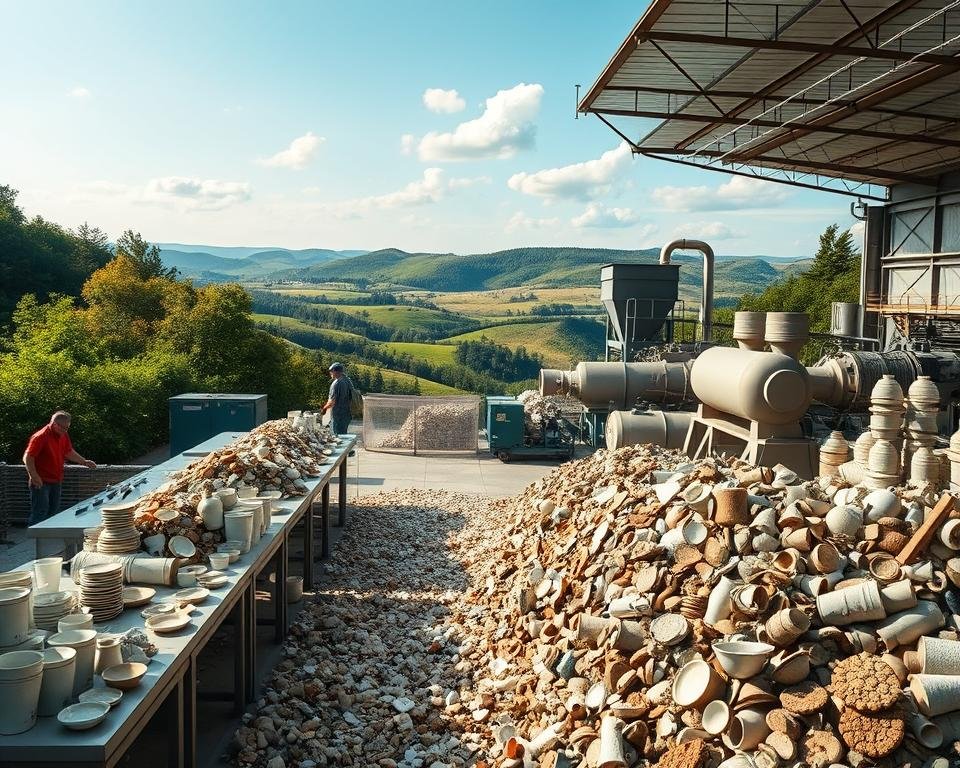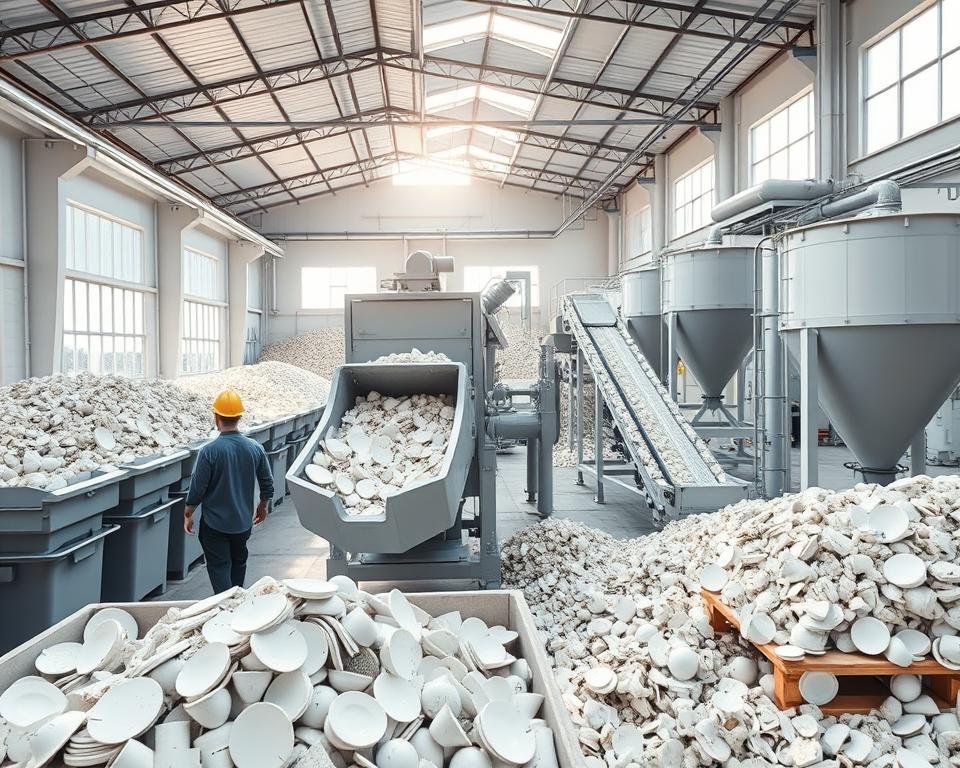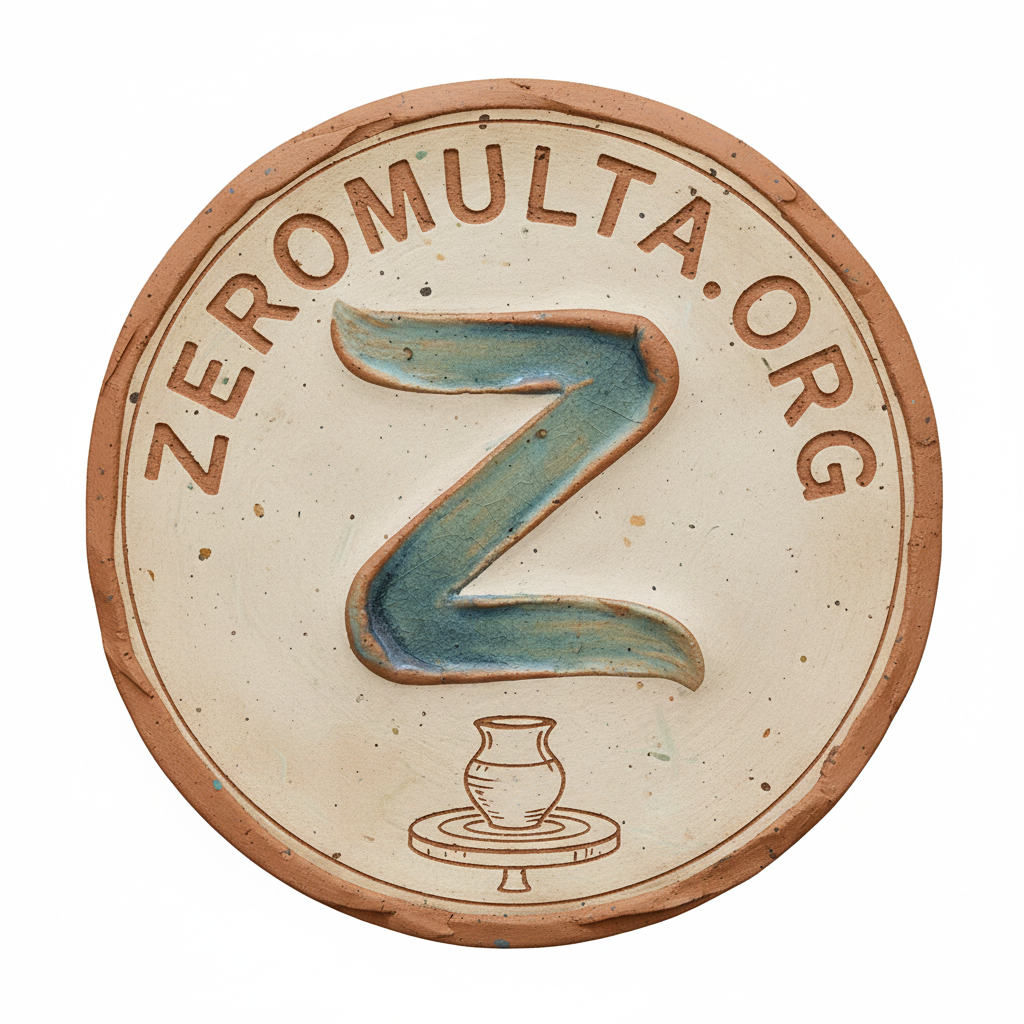Did you know the ceramics industry creates a lot of waste? This waste harms our environment and makes waste management tough. I’m here to talk about green ways to get rid of ceramic waste.
We can lessen the harm ceramics cause by using eco-friendly methods. In this article, we’ll look at why it’s key to dispose of ceramic waste right. We’ll also check out ways to do it, helping our planet.
Key Takeaways
- Eco-friendly disposal options for ceramic waste
- Importance of proper ceramic waste management
- Methods for reducing environmental impact
- Sustainable practices in ceramic production
- Benefits of adopting environmentally responsible disposal practices
Understanding Ceramic Waste and Its Impact
Ceramic waste is a big deal in waste management. It includes many things like broken pottery and ceramic tiles. It also includes industrial and sanitary ware.
What is Ceramic Waste?
Ceramic waste is anything made from ceramic that’s no longer needed. This includes things like broken dishes and industrial ceramics. It also includes ceramics from construction sites.
Why Proper Disposal is Important
Proper disposal of ceramic waste is key for the environment. If not disposed of right, it can pollute and harm water quality. Recycling and eco-friendly methods help solve these problems.
Here’s why proper disposal matters:
| Reason | Description | Impact |
|---|---|---|
| Landfill Reduction | Proper disposal reduces the amount of waste sent to landfills. | Conserves landfill space and reduces environmental harm. |
| Pollution Control | Eco-friendly disposal methods minimize the release of harmful substances. | Protects air and water quality. |
| Resource Conservation | Recycling ceramics conserves raw materials and energy. | Reduces the need for extracting and processing raw materials. |
Knowing about ceramic waste and its disposal is key. Recycling and reusing ceramics help manage waste. They also help make our future more sustainable.
Types of Ceramic Waste
Different types of ceramic waste need different ways to be disposed of. Ceramic waste comes from many places, and knowing what we have is key to recycling right.
Household Ceramic Items
Broken dishes and cups from home are a big part of ceramic waste. These items can be donated or recycled. Many places have programs for recycling ceramics.
- Look for local thrift stores or charities that take used ceramics.
- Join community events for recycling household waste, including ceramics.
Industrial Ceramic Waste
Industrial waste comes from making things like tiles and bathroom fixtures. It’s big and can harm the environment. Companies are now using sustainable practices to reduce waste.
- Start by cutting down on waste at the source.
- Work with recycling places that can handle industrial waste.
Potteries and Crafts
Waste from pottery and crafts includes clay, glazes, and fired pieces. Artists can reuse materials and dispose of waste properly. Some studios join ceramic recycling programs to reduce waste.
Knowing about different ceramic waste types helps us dispose of it better. Whether it’s from home, industry, or crafts, each part helps solve the waste problem.
Looking for local recycling centers and community projects is key. It helps manage waste and supports green practices in our areas.
Environmental Implications of Improper Disposal
Improper disposal of ceramic waste has many serious environmental effects. It can cause a lot of damage to our planet.
Landfill Concerns
Ceramic waste in landfills takes hundreds of years to break down. It takes up a lot of space and produces methane, a harmful gas. A study found that ceramics slow down the breakdown process even more ceramic waste research.
Pollution and Water Quality
Ceramic production uses chemicals that can pollute water if not disposed of right. This can harm both people and the environment.
| Disposal Method | Environmental Impact | Eco-Friendly Alternative |
|---|---|---|
| Landfilling | Occupies space, produces methane | Recycling |
| Improper Disposal | Chemical contamination of water | Eco-friendly disposal techniques |
Using eco-friendly ceramic waste disposal methods is key to solving these problems. Recycling and proper landfill management can greatly lessen the harm caused by ceramic waste.
Eco-Friendly Disposal Methods
Ceramic waste disposal doesn’t have to harm the environment. Many sustainable options exist. Recycling, donation, and reuse can greatly reduce ceramic waste’s environmental impact.
Recycling Ceramics
Recycling ceramics is a good way to manage waste. It breaks down items into raw materials for new products. Recycling ceramics saves natural resources and cuts down landfill waste. To recycle, find out which ceramics local facilities can process.
- Check with local recycling centers to see if they accept ceramics.
- Ensure the ceramics are clean and free of contaminants.
- Some communities have special collection events for hazardous waste, which may include ceramics.
Donation and Reuse Options
Donating or reusing ceramic items is also effective. Many groups take gently used ceramics for resale or repurposing. Creative reuse can breathe new life into old ceramics, like turning plates into wall hangings or planters. Donating and reusing not only cuts waste but also helps local communities and artists.

By choosing eco-friendly disposal methods, we can help manage ceramic waste better. Recycling, donation, or creative reuse all play a part in reducing ceramic waste’s environmental impact.
How to Identify Recyclable Ceramics
Knowing which ceramics can be recycled is key to sustainable disposal of ceramic waste. Different ceramics have unique properties. It’s important to understand these differences for effective recycling.
Types of Ceramics That Can Be Recycled
Some ceramics are more likely to be recyclable than others. For example, porcelain and earthenware are often accepted by recycling programs. This is because of their material makeup.
Let’s look at common ceramic types and their recyclability:
| Ceramic Type | Recyclable | Notes |
|---|---|---|
| Porcelain | Yes | Often used in fine china and decorative items. |
| Earthenware | Yes | Commonly found in pottery and planters. |
| Stoneware | Sometimes | Depends on the glaze and firing process. |
| Bone China | Rarely | Specialized recycling programs may exist. |
Guidelines for Preparation Before Recycling
Before recycling ceramics, proper preparation is essential. This includes sorting, cleaning, and sometimes processing them. This makes them ready for recycling programs.
Here are the steps to take:
- Sort ceramics by type to ensure they are compatible with the recycling program.
- Clean the ceramics to remove any food residue or contaminants.
- Check with local recycling centers for specific guidelines on preparing ceramics for recycling.
By following these guidelines and knowing which ceramics can be recycled, we can help the environment. It’s a simple yet effective way to make a positive impact.
Local Resources for Ceramic Waste Disposal
Knowing your local resources is key to eco-friendly ceramic waste disposal. There are many ways to manage ceramic waste responsibly. Let’s explore these options together.
Finding Recycling Centers
Recycling centers play a big role in managing ceramic waste. To find one near you, start by contacting your local waste management. You can also search online for “ceramic recycling centers near me.” Many places have facilities that accept ceramic materials. Here’s how to find them:
- Visit the Earth911 website or call their hotline to find recycling centers in your area.
- Check with local ceramic suppliers or pottery studios; they often have information on where to recycle ceramic waste.
- Contact your local government’s waste management department for guidance on disposal options.

Community Initiatives and Programs
Many communities have programs to reduce waste, including ceramic waste. These can include special collection events or drop-off locations. Keep an eye out for community newsletters or local government websites for announcements. Here are some examples:
- Community collection events where you can drop off ceramic items.
- Local non-profit organizations that accept ceramic donations for reuse or recycling.
- Creative reuse programs that turn ceramic waste into new products.
By using these local resources, we can make a big difference. It’s all about working together and being aware of our actions.
Key Takeaways:
- Identify local recycling centers that accept ceramic waste.
- Participate in community initiatives and programs for ceramic waste disposal.
- Spread awareness about the importance of eco-friendly ceramic waste disposal.
DIY Projects for Reusing Ceramic Waste
Reusing ceramic waste is good for the planet and fun. You can turn old ceramic items into something new and useful. This can be for your home or garden.
Upcycling Ideas for Home Decor
Upcycling ceramic waste makes your home special. You can make decorative wall art from old plates. Or, create mosaic tabletops with broken pieces.
Another idea is to make customized planters or vases. Mixing different shapes and sizes makes a beautiful display. It adds character to any room.
Creative Uses in the Garden
Ceramic waste is great for garden projects. You can make a mosaic pathway or decorate garden borders with colorful shards.
Old ceramic pots can become stepping stones or bird baths. Being creative with ceramic waste beautifies your garden and reduces waste.
These DIY projects help dispose of ceramic waste properly. They also make unique items for your home and garden.
Industry Innovations in Ceramic Waste Management
New ways to handle ceramic waste treatment are changing the game. The ceramic industry is moving towards more sustainable practices. This is all about reducing its environmental impact.
New Technologies in Recycling
New tech is making recycling ceramic waste better. Advanced sorting tools help separate ceramic waste from other trash. This makes recyclables of higher quality.
Also, new methods are being created to recycle complex ceramic items. This makes recycling more possible.
Nano-technology is being looked into for breaking down ceramics. It could make ceramics reusable. This helps reduce waste and opens up new uses for ceramics.
Case Studies of Successful Programs
There are many success stories in ceramic waste management. For example, a big ceramics factory has a closed-loop system. They collect, process, and reuse ceramic waste. This cuts down the environmental harm of making ceramics.
Another great example is a community effort. They set up a network to collect and recycle ceramic waste. It not only cuts down waste but also teaches people about ceramic waste treatment.
These stories show that with technology, community help, and industry effort, we can manage ceramic waste well.
Legislation and Policies on Ceramic Waste
Legislation is key in managing ceramic waste. As we become more eco-friendly, laws on waste disposal are getting tougher.
In the United States, both federal and state laws affect ceramic waste management. There’s no single federal law for ceramic waste. But, many environmental laws guide how it’s handled.
Current Laws in the United States
The Resource Conservation and Recovery Act (RCRA) is a major federal law. It deals with hazardous waste, including some ceramic waste. Not all ceramic waste is hazardous, but RCRA shapes waste management.
State laws differ a lot. Some states have special programs for recycling ceramic waste. Others have broader policies that include ceramics.
| State | Ceramic Waste Policy | Recycling Programs |
|---|---|---|
| California | Strict regulations on waste disposal | Yes, extensive recycling programs |
| New York | Regulations on hazardous waste | Limited recycling programs for ceramics |
| Texas | General waste management policies | Some local recycling initiatives |
Future Legislative Trends
As environmental worries grow, laws on ceramic waste will likely get stricter. There’s a push towards a circular economy. This means more reuse and recycling, including ceramics.
New laws might give clearer rules on how to dispose of ceramic waste. They could offer rewards for recycling and fines for not following rules.
It’s important to keep up with these changes. This helps individuals and companies follow rules and use eco-friendly practices for ceramic waste.
Tips for Reducing Ceramic Waste at Home
Reducing ceramic waste at home is a big goal for me. Making a few simple changes can help us live more sustainably. This way, we can lessen our environmental impact and live more eco-friendly.
Mindful Purchasing Habits
Being mindful of what we buy is key to reducing ceramic waste. I look for durable and high-quality items. This way, we can avoid throwing them away too soon.
- Opt for timeless designs over trendy ones to ensure the item remains relevant for years to come.
- Check the manufacturer’s reputation for producing high-quality ceramics.
- Avoid single-use ceramics and instead choose items that can be used multiple times.
The Environmental Protection Agency (EPA) says reducing waste is vital. By buying wisely, we can help cut down ceramic waste.
“The clearest way into the Universe is through a forest wilderness.” – John Muir
Maintaining and Repairing Ceramics
Keeping ceramics in good shape can also help reduce waste. By taking care of them, we can avoid needing to replace them too often.
| Maintenance Tips | Repairing Techniques |
|---|---|
| Handle ceramics with care to avoid chips and cracks. | Use a ceramic repair kit to fix minor damages. |
| Store ceramics properly to prevent breakage. | Apply a clear epoxy to reattach broken pieces. |
By following these tips, we can greatly reduce ceramic waste. Making eco-friendly choices in our daily lives is important. It has a big impact on our planet.
Conclusion: Making a Difference with Responsible Disposal
It’s up to all of us to properly dispose of ceramic waste. By using eco-friendly methods and recycling, we can greatly reduce harm to our planet.
Eco-Friendly Practices for a Greener Future
I urge you to help protect our environment by managing ceramic waste wisely. Proper disposal and using the right techniques are key to a greener tomorrow.
For more details on safe disposal, check out Ultimate Dumpsters. They offer tips on how to dispose of ceramic waste safely and help our planet.
Final Steps Towards Sustainability
Let’s all support sustainable living and community projects to cut down ceramic waste. Every little bit we do can add up to big changes for the better.
